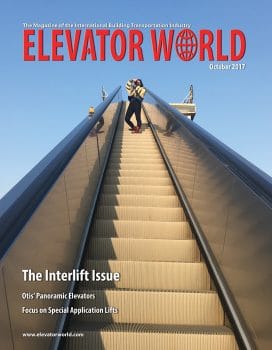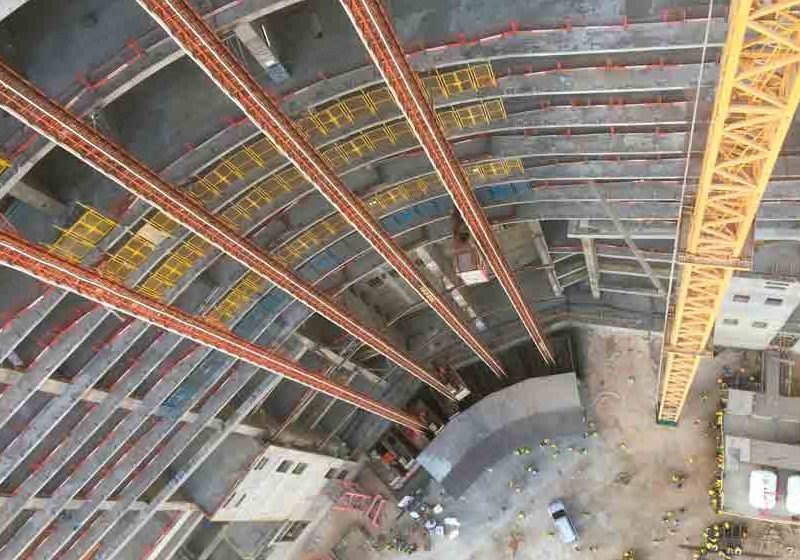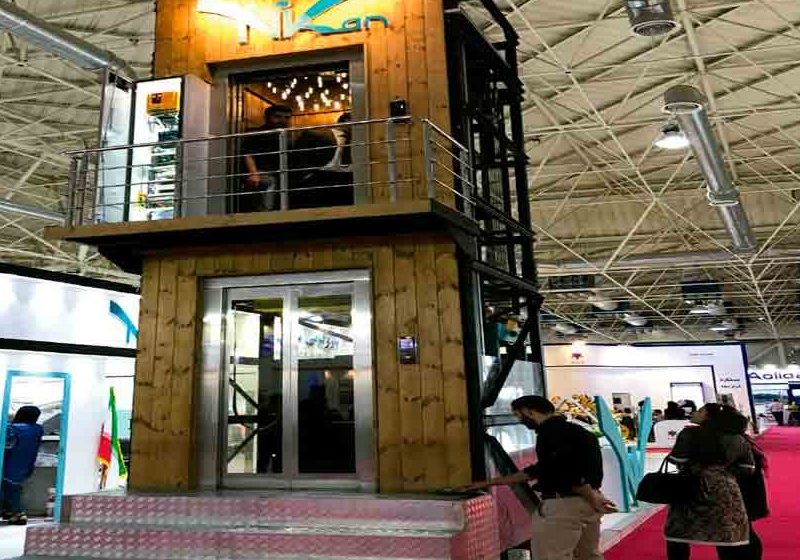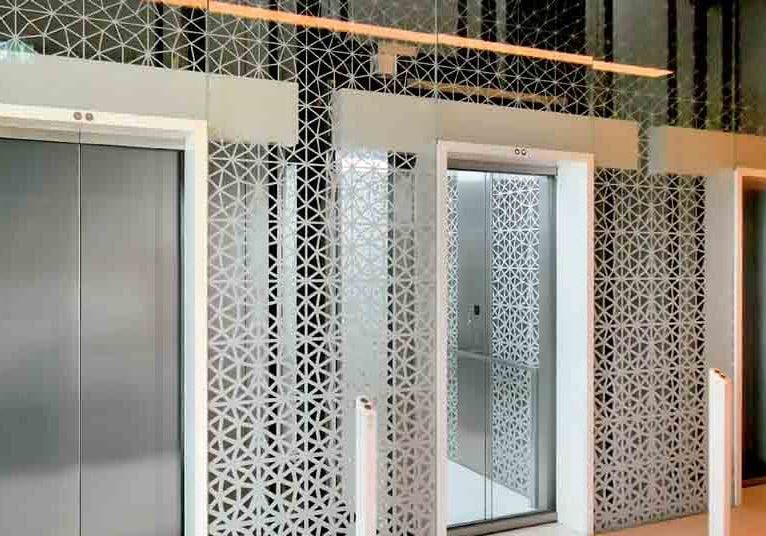Use of Lifts Increasingly Important in Evacuations from Buildings
Oct 1, 2017

New European standard prEN 81-76 is in development to address the issue.
The use of lifts in the evacuation of persons is getting increasing attention. Whereas the motto used to be, “In case of fire do not use elevators use stairs,” realization that the lift is critical in an evacuation, particularly where elderly and disabled persons are included, has grown.
In extremely tall buildings, with heights of about 1,000 m, “lifeboat” lifts are already being deployed. These are used for transporting everyone in a building from a gathering floor to the ground floor under the supervision of a dedicated and specifically trained person. These lifeboat lifts are especially designed for this purpose. Their temperature and humidity resistance is in accordance with the intended use, which also applies to the structural environment, so that any extinguishing water and smoke is discharged, electricity to the lift is ensured and flames are kept away from the machine room, lift shaft and lift-shaft access via effective fire compartmentation.
Further Studies
In parallel with the further development of lifeboat lifts, the realization that evacuation is also required for shorter buildings has grown. Experiences during essential evacuations in tall, but not extremely tall, buildings have confirmed this. A relatively large number of people managed to exit the World Trade Center Twin Towers in New York City during 9/11 not by taking the stairs, but by using the lifts to escape from the building. The report “Evacuation From High-Rise Buildings using Lifts and Stairs” (liftinstituut.com/images/pdf/backgroundreport.pdf) issued in 2013 made a good contribution to the discussion. Experience regarding evacuation from high-rise buildings was also taken into consideration in the creation of this report. In addition to providing clarity regarding the various evacuation options, the purpose of the study was to develop a calculation model to make it possible to determine the optimal evacuation strategy for high-rise buildings in different scenarios. This report and other recent studies and research point out that the use of lifts could be an efficient way of evacuating buildings in case of emergencies. This is especially true for tall buildings, but also for smaller buildings and in the evacuation of disabled persons.
Esfandiar Gharibaan, chairman of CEN TC 10, told us that Working Groups CEN TC 10 and ISO TC 178 have been examining specific evacuation provisions for persons:
“CEN has been focusing on the assisted evacuation of disabled persons by trained attendants. As a result, CEN/TS 81-76 provides specification for lifts in such a situation. CEN/TS 81-76 is now being revised to be published as a new standard, EN 81-76. ISO has been working on evacuation of buildings in general and has published ISO/TS 18870. The use of lifts in [the] evacuation of buildings has been implemented in many buildings around the world, and as the experience with such application is accumulating, ISO TC 178 may decide to develop a standard. Maybe this will lead to lifts with specific evacuation provisions for persons, for example, ‘life boat’ evacuation.”
Firefighter Lift Standard EN 81-72:2013
In addition to lifts that can be used in evacuations, there are also lifts that can be used by firefighters. A specific standard for this has been developed. These lifts are intended to take firefighters with their equipment to near the seat of the fire. Here, too, the temperature and humidity resistance of the lift must be in accordance with the intended use. This also applies to the structural area, although this depends on national regulations. The standard also describes special control features allowing for priority operation by firefighters. The latest version of this standard for firefighter lifts, EN 81-72:2013, has been amended on various points and is intended as the standard for lifts built subject to EN 81-20/50. Like the previous version of EN 81-72, this version is intended for transporting not only firefighting equipment, but firefighters, as well. They can also free themselves from the lift in the case of any unforeseen malfunctions.
Lifts for Evacuation and Firefighter Use
Although firefighter lifts built in accordance with EN 81-72 are not primarily intended for the evacuation of persons, they can be used for this purpose by the fire brigade. However, it is important that evacuation starts immediately after the alarm has been triggered and is, therefore, possibly available before the fire brigade arrives. It is also important that this evacuation takes place under supervision and in close consultation with the evacuation coordinator. There are also important lift features other than those in firefighter lifts. These relate to signaling at the shaft accesses and to communications equipment. Globally, the same requirements apply in respect to heat and humidity resistance, compartmentation and fire-safe supply.
Standard for Evacuation Lifts for Disabled Persons
EN 81-76, specific for the evacuation of disabled persons, is in development within CEN TC 10. The prEN 81-76 version is available for feedback. This standard describes a lift to be used for the evacuation of persons with disabilities and persons with impaired mobility under the direction and control of the building management and specially trained persons. In the Annex, the standard provides a concept for the use of an evacuation lift. The intended use of the lift, whether to use it for evacuation and when to remove it from evacuation service, is assumed to be a building-management decision.
Assumptions
The most important assumptions in this standard are:
- The building is provided with means to protect the lift from the effects of fire and smoke for at least the maximum planned duration of the evacuation.
- Some form of fire and smoke detection is provided.
- Power supplies are secure and reliable.
- Safe evacuation is under the control of trained persons located at the building premises.
- The building is designed to minimize the risk of flooding into the lift or lift well.
- Negotiations have been made between the owner, customer, building designers, fire authorities or other relevant bodies and installer concerning the evacuation plan.
Note that developers and architects will need to take account of national building regulations.
Operation
The lift, which functions as a passenger lift during normal operation, is equipped with a switch on the main landing for putting the lift into evacuation mode. The switch will be marked with the sign shown in Figure 1, and it will be clearly indicated as to which lift it is associated. At each landing, an additional signaling panel must be fitted. The lift can then be operated exclusively from the cage by authorized staff. These members of staff are, in turn, in contact with the evacuation management. They run the evacuation. At all shaft accesses, a pictogram shows that the lift is running in evacuation mode.
Combination With Firefighter Switch
These evacuation lifts can also be suitable for use as firefighter lifts. For this purpose, a dedicated switch with the associated marking must be fitted on the main landing. Upon arrival, firefighters may overrule the evacuation mode by using the firefighter switch.
Get more of Elevator World. Sign up for our free e-newsletter.







